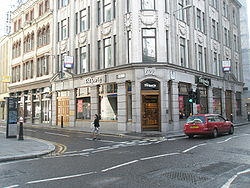- St Dionis Backchurch
-
St Dionis Backchurch
Current photo of siteCountry United Kingdom Denomination Anglican St Dionis Backchurch was a parish church in the Langbourn ward of the City of London.
Contents
History
The church of St Dionis was dedicated to Dionysus the Areopagite, a follower of St Paul, said to have converted the French to Christianity. He became the patron saint of France, where he is known as St Denis. The name Backchurch may have come from it standing behind other buildings, or from its position relative to the church of St Gabriel. It was in existence by the year 1288. In 1466 the Alderman John Darby had an aisle added, in which he was buried. The church was destroyed in the Great Fire of London in 1666, and rebuilt to the designs of Christopher Wren in 1674 at a cost of £5737.[1] A tower was added ten years later.
Wren’s church was 66 feet long and 36 feet wide. It had an aisled nave, the arcades formed by Ionic columns supporting an entablature. The ceiling was arched, and pierced with circular windows under groin vaulted openings. There was a west gallery with an organ.
The bell tower was divided into three storeys by string courses. At the top was an open parapet, and a small bell turret which had been removed by the nineteenth century. [2] The church was built mostly of stone, with some brick which was later stuccoed. [3] The east end of the church, in Lime Street had a pediment and two pairs of coupled Ionic pilasters with a large window and carved festoons above. [2]
In 1858, the vestry asked the architect George Edmund Street to examine the fabric of the church. He found that the church was in need of substantial repairs and recommended that the most economical course of action would be to demolish the whole church except for the tower, and rebuild it to a gothic design of his own. Before the plans could be carried out however, the vestry decided that the church was no longer needed. In 1878 the parish was merged with that of All Hallows Lombard Street under the Union of Benefices Act of 1860 and the church demolished.
While surveying the church, Street discovered that a fifteenth century crypt had survived under the chancel of Wren’s church.[4]
The church had a peal of ten bells, cast between 1726 and 1750. They were transferred to All Hallows Lombard Street when St Dionis was demolished.
A parish mark can be seen in Philpot Lane. The church of St Dionis, Parsons Green was built with the proceeds of the sale of the site of the City church, and its font and pulpit survive there.[5][6]
The modern reincarnation in Parsons Green
The burials were re-inhumed at the City of London Cemetery.
See also
- List of Christopher Wren churches in London
- List of churches rebuilt after the Great Fire but since demolished
References
- ^ Jeffrey, W (1824). London Parishes.
- ^ a b Godwin, George (1839). Churches of London. London.
- ^ Elmes, James. Topographical Dictionary of London, p.164
- ^ "St. Dionis Backchurch". The Civil Engineer and Architect’s Journal 21: 383. http://books.google.co.uk/books?id=lMNAAAAAcAAJ&printsec=frontcover. Retrieved 23 June 2011.
- ^ Christopher Howse. "Wren's tall tower in Twickenham". The Telegraph. http://www.telegraph.co.uk/comment/columnists/christopherhowse/7944922/Wrens-tall-tower-in-Twickenham.html. Retrieved 19 May 2011.
- ^ Modern church web site
External links
- www.oldlondonmaps.com - engraving of the 1674 church
- St Dionis Parsons Green - Website of the current church at Parsons Green
Categories:- Buildings and structures demolished in 1878
- Churches rebuilt after the Great Fire of London but since demolished
- Christopher Wren churches in London
Wikimedia Foundation. 2010.


